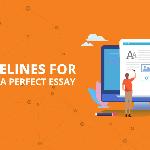4 tips to write an ideal conclusion

As the end nears in an essay, most people often get flustered because finding the key points of an essay and then making them as concise as possible, might feel like a bit of a task. It’s not a no-brainer task. However, clustering the essentials of an essay is not entirely as hard as it looks. A conclusion brings together an essay in a clear fashion, and the reader gets an overall idea about the message, the essay tries to communicate. Getting a spot on conclusion will no more be hard and here’s how you can hone the skill of writing a succinct conclusion:
1. Spotlight the crux of the essay
Scan through your essay to pluck points that deliver the purpose of the essay. Be careful about filtering the points to include only the significant ones over the less important ones. Crowding the conclusion of an essay with unnecessary information might deviate the reader from absorbing important information. You could pick these points by beginning from the first paragraph and then the following paragraphs.
2. Keep it simple and devoid of complex information
Avoid using jargon which could possibly confuse the reader. You want to make the reader understand the objective in a way that will give clarity but also evoke an interest in the reader to explore the topic further. Despite the point of a conclusion being to equip the readers with a sense of closure on the topic, it is also important for the reader to still cling to the topic in order to discover new things on the same subject.
3. Walk down the foyer of findings and inferences
A good conclusion should clarify all the doubts and questions that the reader might have possibly encountered while reading your essay. To achieve this, the writer of the essay must also scan for any possible open-ended facts and attempt to make them clearer by stating the findings or any analogies. Findings, essentially validate the essay by providing evidence that will support the purpose of the essay. The key is to make the findings as concise as possible and avoid piling up too much incomprehensive information on the reader.
4. Avoid rambling on, because you already have
The reader has no time to pay attention to every single detail in the essay, and this is where a conclusion comes into play. If a conclusion is almost the size of the rest of the paragraphs, there are chances that the reader might be put to slumber. The conclusion should intrigue the reader rather than boring them. Pay constant heed to the sentences and their length, because if the readers were on the lookout for length, they might as well have walked the shore of the Nile river.
As writers, the vitality of a conclusion must be embedded in our system, and it can only happen through practice. As Robert Downey J. says,” Part of the journey is the end,” the conclusion marks the closure of the essay but still should manage to make the topic swarm in our heads. A conclusion that leverages on all the above characteristics, takes home the prize.

 Previous Post
Previous Post Next Post
Next Post